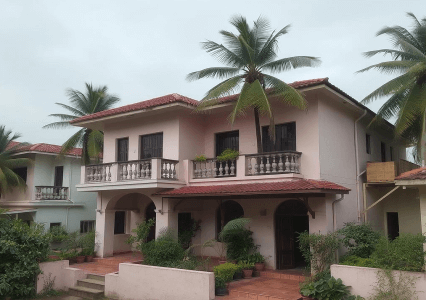
Virtual Reality (VR) in real estate is revolutionizing the way properties are marketed and purchased by offering immersive, 3D tours that allow potential buyers to experience homes from anywhere in the world. This technology is particularly valuable in the luxury market, where buyers may want to view high-end properties without physically visiting them. Here’s how VR and 3D tours are changing the home-buying experience:
- REMOTE VIEWING AND ACCESSIBILITY
- Global Reach: Buyers no longer need to travel to view properties. With VR, they can take detailed virtual tours from the comfort of their own homes, opening up the market to international buyers or those relocating from different cities.
- Time-Saving: Instead of visiting multiple homes in person, buyers can narrow down their choices by touring properties virtually. This allows them to focus on a few select homes for physical visits, saving time and effort.
- ENHANCED VISUALIZATION AND IMMERSION
- Life-like Experiences: VR tours offer a fully immersive experience where buyers can explore every corner of a home, from walking through rooms to inspecting architectural details and finishes. This creates a "being there" experience that static images or videos can’t offer.
- 3D Interactive Walkthroughs: Unlike traditional property photos, VR allows users to move freely within a 3D-rendered environment, making it easy to visualize spatial dimensions, layouts, and how different spaces connect.
- Multiple Views: Some VR platforms offer various modes, such as “dollhouse view” or floor plan view, allowing buyers to see how different rooms are laid out and understand the flow of the property.
- CUSTOMIZATION AND STAGING OPTIONS
- Virtual Staging: VR technology enables virtual staging, where empty homes can be digitally furnished and decorated to help buyers envision what the property could look like with different styles or furniture arrangements.
- Customization Features: Developers and real estate agents can offer customization options where potential buyers can visualize changes, such as different paint colors, flooring, or kitchen designs. This can be especially helpful in new construction homes.
- EMOTIONAL CONNECTION
- Creating Emotional Engagement: One of the biggest advantages of VR tours is the emotional connection they can create. Buyers can imagine themselves living in the space, which enhances decision-making and boosts sales potential.
- 24/7 Open Houses: Virtual tours serve as digital open houses that are accessible 24/7. Buyers can revisit the tour multiple times, taking a closer look at the home at their own pace and convenience.
- COST-EFFECTIVE FOR SELLERS AND DEVELOPERS
- Reduced Marketing Costs: VR tours eliminate the need for constant in-person showings, which can be time-consuming and costly. For developers, virtual tours can also be created before construction is complete, enabling pre-sales of properties.
- Fewer Physical Staging Needs: Virtual staging reduces the need for expensive physical staging, saving sellers and developers money while still making the property attractive to potential buyers.
- COVID-19 AND THE RISE OF VIRTUAL TOURS
- Safe and Contactless Viewing: The COVID-19 pandemic accelerated the adoption of VR in real estate. Social distancing and safety concerns led to a significant increase in virtual property viewings, a trend that is expected to continue even post-pandemic.
- Virtual Open Houses: Real estate agents hosted virtual open houses to reach potential buyers when in-person visits were restricted. This made virtual tours a vital tool in the industry.
- INCREASED BUYER CONFIDENCE
- Comprehensive Property Understanding: 3D tours provide buyers with a comprehensive understanding of the property. By allowing them to explore every detail, it reduces uncertainties, which can increase buyer confidence.
- Decision-Making Power: Buyers can make more informed decisions when they have a detailed view of the property layout, size, and features, leading to faster transactions and fewer surprises during in-person visits.
- INTEGRATION WITH AUGMENTED REALITY (AR)
- Enhanced Experience: Augmented reality (AR) can be integrated with VR to allow buyers to superimpose virtual elements (such as furniture or decor) onto real-world environments. This adds an extra layer of interactivity, letting users modify and interact with spaces in real-time.
- Customization in Real-Time: AR allows potential buyers to customize the home by virtually adding features, such as trying out different flooring materials, furniture, or lighting options, making the buying process more personalized and interactive.
- BUILDING BUYER TRUST
- Transparency: VR tours offer a high level of transparency. Buyers can see every part of the home and its surroundings, reducing the possibility of surprises later on. This is particularly useful in high-value real estate transactions, where confidence and trust are paramount.
- FUTURE OF PROPERTY SALES
- Virtual Transactions: The future of real estate may involve fully virtual transactions, from viewing the property through VR tours to signing contracts electronically. As VR technology continues to evolve, more immersive, and realistic experiences are expected to emerge, further reducing the need for physical presence during the home-buying process.
Conclusion: Virtual reality and 3D tours are reshaping the real estate industry, making it easier, faster, and more efficient for buyers to explore properties. From immersive walkthroughs to virtual staging and customization, these tools are enhancing the home-buying experience, increasing engagement, and transforming how buyers and sellers interact with the market. As VR technology continues to improve, it is likely to become an essential component of real estate marketing, especially in the high-end and global property markets.


